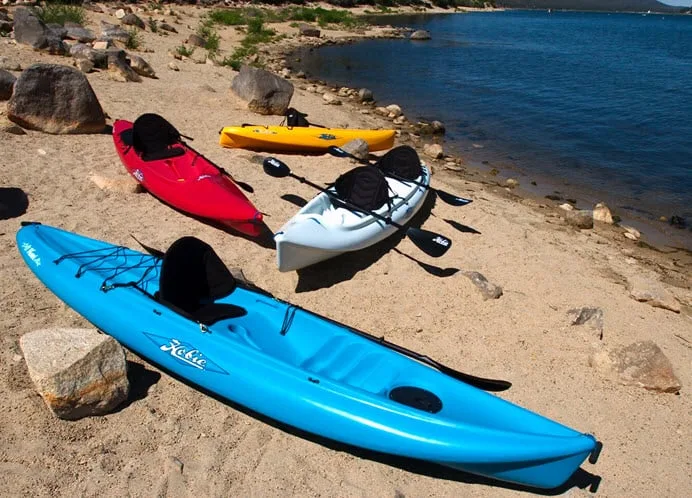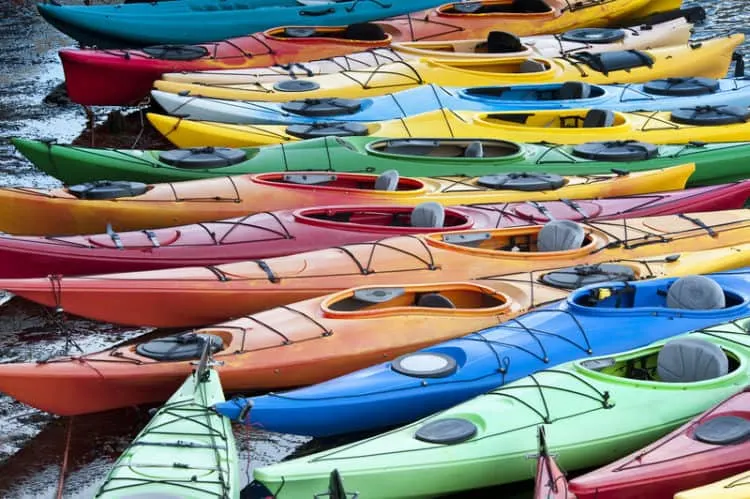When my wife and I embarked on buying a kayak, we were faced with a lot of choices, choices that have multiplied tenfold as the popularity of paddling has grown exponentially.
For my family, kayaks became a priority when we purchased a travel trailer. We could no longer tow our boat on camping trips, so we wanted something lightweight to throw on the roof of our tow vehicle.
After years of pairing in a canoe, we knew a tandem (two-seater) kayak was out of the question. You need a lot of harmony in a marriage for two people to paddle one boat, especially explorers who seek side trips, hang back for the perfect photo or go for a swim without rocking the boat.
For us, it was a no-brainer: we were going solo. Call it marriage preservation.
The next issue was whether to buy a sit-inside or a sit-on-top. Taking a cue from friends, we bought one of each. My wife prefers the security of a sit-inside, while I liked the idea of a sit-on-top for ocean surf, or rolling off the boat for a swim in open water.
And then there was weight. We wanted kayaks light enough to hand-carry and throw onto the roof of our truck without extraordinary effort.
We tried several kayaks at local dealers. Kathy settled on a wide-beam, 9-foot , 34-pound Perception Sparky, an entry-level yak with a large cockpit that would make it easy to jump ship. The bonus was that the cockpit was large enough that she could take our dog for a paddle. She loves it.
As a Hobie Cat aficionado from my beach sailing days, I chose a narrow-beam 12-foot sit-on-top Hobie Pursuit instead of my researched choice, a sit-inside Wilderness Systems Pungo, which my dealer suggested. My Hobie Pursuit is a fast and nimble boat, and it’s easy to re-board in open water after a swim or snorkeling, but it’s not a very stable platform for fishing. I still long for the Pungo. The dealer was right.
Everything, you will soon learn, is a compromise
Tandem vs. Solo

As I mentioned, we decided on solo kayaks. We still paddle together but have the option to go our own way, and we often do. Tandem kayaks offer the idyllic dream of togetherness, but they sometimes require extraordinary patience. Rent one and take a long paddle with your partner to see if your relationship can withstand it. (Paddles make formidable weapons!)
On the other hand, you can build up a great deal of speed when two people are paddling, and full synchronization of paddle strokes as you zip along the water can be a lot of fun. Even a leisurely paddle takes less work with two people powering the craft.
Keep in mind that tandems may be difficult to maneuver if you go solo.
Wide vs. Narrow, Short vs. Long
The wider the kayak, the more stable it will be, but harder to paddle. The longer and narrower the kayak, the faster it will go and it will be easier to paddle. Longer kayaks tend to track better in a straight line, but they don’t turn as easily. If you paddle the narrow Loxahatchee River, for example, a short, nimble kayak is in order. If you plan to traverse open bays with the potential of high winds, then a longer kayak will hold its track.
In Florida, you have many water environments to try – swamps, bays, open ocean, rivers and small creeks — so the best choice will probably be a compromise.
Speaking for myself, speed turned out to be not as important as I thought it would be. I like leisurely paddle trips and wish I had a better platform for fishing, so I should have gone a wider with more stability and additional deck space for tackle and storage for my catch.
Flat water vs. Surf
If surf-riding in modest seas is your intent, almost any wide-beam sit-on-top will do the trick. If you capsize, you get thrown from the boat rather than going under the surf strapped into a cockpit. A keel is also desirable for stability as your ride waves, and advanced surf yaks have rudders and/or underwater fins (like surfboards) to enhance maneuverability.
If long-distance ocean paddling is your goal, then a well-designed sea kayak should be in your sights – long and narrow with a small cockpit, a rudder, and secure spray skirt to keep out the always-invasive seas. Sea kayaks are as long as 15 to 20 feet and can get expensive. Comfort is paramount.
In other states, whitewater kayaking is among the options, requiring a whole different vessel. We don’t need to worry about that in Florida.
For most of us, a versatile, inexpensive 9- to 12-foot sit-inside or sit-on-top yak will serve our needs — perfect for paddling our numerous slow-moving rivers, lakes, bays and backwater estuaries.
Sit-on-top vs. Sit-inside

Newcomers to the sport worry about “the roll” of a sit-inside, and you should learn how to survive in an emergency. If you are afraid of the roll, or don’t want to learn it, then get a large cockpit that will let you slide out, or buy a sit-on-top that lets you slide off. Either way, practice makes perfect. Intentionally roll out of your boat in calm, shallow water.
Rolling off the boat for a swim, snorkel or a dive is far easier from a sit-on-top. Most have a deck surface to store your wet gear, and sit-on-tops are easier to reboard — something to consider, especially if you frequent the Florida Keys.
Sit-insides are more stable and feel more secure because your center of gravity is lower. With the sit-on-top, your body is above the water line, requiring more balance and alertness.
Keep in mind that you get more storage under the decks with a sit-inside, although with either sit-ins or sit-ons, you need dry bags for overnight camping trips.
Weight
Most kayaks are lightweight boats that can be handled and transported easily. When you are buying a kayak, the difference between a 35 pound boat and a 60-pounder may be the difference between a fun day on the water or leaving the boat at home because you don’t want to lug it around.
My wife likes her little 34-pounder because she can carry it alone, grabbing the lip around the cockpit with one hand. Sit-on-tops have limited handholds, although most kayaks have handles. Heavier kayaks like mine require a little more muscle, but two people can carry most kayaks easily.
If you are alone, you may want a wheel cart. Dragging your investment on the ground will eventually tear up the hull.
My friend Warren Richey, a long-distance sea kayaker and author of “Without A Paddle,” has a boat that weighs 200 pounds when packed with camping gear and supplies, as it often is. He carries wheels on the boat for portages. Empty, his boat is light and fast but still requires wheels because of its length (17 feet).
Color

Kayaks come in a variety of colors and hues, and while you may think the color choice is strictly a vanity issue, it’s not. There are safety issues to consider when buying a kayak.
Being small boat with a low profile on the water, a kayak is not easily seen by other boats. If you paddle in open water or along waterways and canals where bigger, motorized boats are present, you want to stand out against the color of the water and nearby land.
Choose a bright yellow, or a bright orange, so you can be seen.
Black is sleek, blue is cool, and dark reds are studly, but when that yahoo in a speedboat cuts across your bow or rides up your behind, you’ll wish you had made a smarter color choice.
While I’m on the subject, choose a bright-color life jacket as well.
Inflatables
I am often asked about inflatables, and I usually recommend against them unless transport space is a high priority. Inflatables have their place, but can be a pain. First, they are inflatable. That means you have to blow them up with each use, then deflate them and fold them up when you’re done.
Inflatables can also be sluggish, although some of the newer inflatables have a hard-shell hull, making them easier to paddle. But then you compromise portability, which is one reason you buy an inflatable in the first place.
If you have a motorhome or a sailboat, inflatables can be packed into a relatively small space and stored out of the way. They also tow better behind sailboats because of their buoyancy.
Inflatables can also be fun in the surf, though they lack the control you may want in the surf zone. They also make a great base for snorkelers and scuba divers who need to transport heavy gear to a dive spot.
Buy Local — and try before you buy
Buying a kayak from a local, proprietor-owned kayak/canoe dealer is best. You’ll be able to try out a variety of kayaks. Almost all dealers have access to water where you can test ride. Many have weekend “demo days” at the beach, the lake or a river.
Sitting in a new kayak — on the water — before the purchase allows you to gauge your comfort level and balance. Every seat pad and foot rest is different, every cockpit a different size, and all three are critical for your comfort. Some kayaks are easier to get into — or out of — than others.
“Demo Days” are also an opportunity to compare notes with other buyers and hear their questions.
Your local dealer will teach you basic paddling techniques and recommend accessories, usually discounted if you buy a boat from them. And many offer outings with experienced guides to help you get the most out of your paddling experience.
Buying a kayak is really not difficult, so don’t let me scare you away, but with so many choices, it does require some deliberation and professional advice.
Big-box and online retailers rarely save you money, and you won’t receive ongoing personal service, a hallmark of a small family operation. Kayaks are very personal watercraft.
Buying from your local dealer is a good investment. They are not just trying to sell you a kayak, they love kayaks.
The Most Popular Kayaks
These are the most admired kayak manufacturers, and their brands are synonymous with kayaking. When you click on a link, you’ll be taken to the manufacturers home page, where you can view their full lines of kayaks and find a local dealer.
- Old Town. — Legendary maker of canoes offers a full line of excellent recreational kayaks.
- Perception — Before kayaks were cool, Perception was building them. Today, they offer one of the best selections of recreational kayaks anywhere.
- Wilderness Systems — Like Perception, Wilderness Systems is one of the most respected kayak brands out there.
- Ocean Kayak — A premier manufacturer of sit-on-top kayaks for use in the surf.
- Hobie — Hobie’s claim to fame is its “pedal kayaks”, which allow you to move hands-free through water, making them an ideal kayak for fishing. Hobie is a legendary manufacturer of beach sailboats, so naturally they have a line of outrigger kayaks with colorful sails and pedals when the wind dies.
- Current Designs — The Cadillac of sea kayaks, Current Designs is noted for its expedition kayaks. Not for everybody, pricey, but perhaps the most respected brand out there. They do offer a small selection of recreational yaks.
Questions and Answers
Q Love your kayaking article. I don’t think I would ever be able to hoist a kayak onto a roof rack. Your thoughts? And yes, I have one of those ridiculous inflatable ones, but it’s still fun. — Sallie
A kayak roller that suctions to your windshield or rear window will significantly reduce the effort to load your kayak on a roof rack. You should also consider a kayak cart for transporting the kayak from your vehicle to the water. I have both.
Inflatables can be great fun, but they have their limitations.
If you have a question or need advice, use the comments below or send an e-mail to [email protected]
Hat tips to my good friend Dave Ryan, a kayak expert at Kenco Outfitters in Kingston, N.Y., who introduced me to kayaking more than 20 years ago, and my frequent Florida kayak companion Warren Richey, author of Without a Paddle: Racing Twelve Hundred Miles Around Florida by Sea Kayak.
Related Articles

Bob Rountree is a beach bum, angler and camper who has explored Florida for decades. No adventure is complete without a scenic paddle trail or unpaved road to nowhere. Bob co-founded FloridaRambler.com with fellow journalist Bonnie Gross 14 years ago.

Nick
Wednesday 25th of August 2021
I understand your concerns with inflatable kayaks, if this was 5-8 years ago. But thinking of the present-day market, I whole-heartedly disagree. For example: many of the models by Advanced Elements inflatable kayaks include internal aluminum framing at the bow and stern to provide serious rigidity. These boats track beautifully on the water and fold into a fairly compact bag (though folding can be a drag). The boats are not very heavy to boot. Inflating takes less than 5 minutes, with a good pump, and similar to deflate. In the water, I doubt most people would feel a difference between an Advanced Elements and a low to mid-tier hard kayak. And, pumping/deflating is not a big deal, compared to lifting and securing to a vehicle. Though I prefer a hard kayak, I highly recommend inflatables for people who do not have space to store and/or transport (which is more people out there than you might be thinking).
joe oneill
Monday 12th of November 2018
Do not forget a whistle. They are required by law in many states and simply make a lot of sense to carry with you if you get lost in the mangroves...